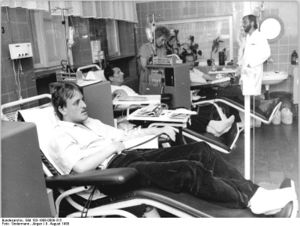Description
Renal rehabilitation (RR) is a coordinated, multifaceted intervention designed to optimize a renal patient’s physical, psychological, and social functioning, thus reducing morbidity and mortality. RR includes five major components: such as exercise training, diet & fluid management, medication & medical surveillance, education, psychological & vocational counselling.[1]
Renal Rehabilitation aims at improving Chronic kidney disease (CKD) patients QOL. The nephrology community felt the need to catch up with cardiology and pulmonary colleagues by adding renal rehabilitation programs for patients with chronic medical conditions, as the benefits to those with CKD on physical function and QOL are many.[2]
CKD is a worldwide public health problem. It is associated with reduced exercise endurance (VO2 max) which further reduces as the renal dysfunction advances. Poor physical condition and skeletal muscle wasting are associated with CKD, being due to the combined effects of uremic acidosis, protein-energy malnutrition and inflammatory cachexia and a sedentary lifestyle. A downward spiral of deconditioning then follows.
Indication
For people with Kidney disorders
A lot of people living with kidney disease find that their fitness levels suffer for a number of reasons. These include: dietary restrictions; changes in muscle structure; changes in blood supply; lack of physical activity This leaves them may leave them feeling lethargic, weak, over weight and with a decreasing QOL. RR aims to redress these issues.
Renal Rehabilitation Programs
Rehabilitation programs are designed to improve everyday life of people suffering CKD, they go over a 6-12 week period typically.
After an initial assessment, a program is tailored to reach each person’s goals and the goals of practitioners and allied health professionals.
The below video gives an idea of what a RR program is like
The below video shows RR at work in a dialysis setting
Physiotherapy
The physiotherapist input in the RR is to design a good comprehensive exercise program. They are held over 6-12 weeks with classes ranging between 1-2 hours, with participants committed to performing exercises at home on at least two other days a week.
The aims are to:
• improve muscle strength, mobility and fitness
• improve quality of life
• reduce blood pressure
• improve blood sugar control
• improve your heart and lung function
• control weight and improve self-esteem
• counteract/reverse the side effects of steroidal treatment, such as muscle wasting, bone thinning and weight gain after transplant.[5]
The program should have a warm up and cool down, a strengthening component, a cardiovascular component and flexibility section. The therapist also needs monitor progression and educate clients in monitoring their progress.
Renal Rehabilitation Evidence
CKD is a progressive condition that adversely affects musculoskeletal health.
A 2018 study reported that secondary sarcopenia due to CKD is associated with malnutrition, osteoporosis, mobility limitations, and elevated fall risk. They found that supervised physiotherapy is an important element in the management of CKD clients to treat: secondary sarcopenia; improving QOL through enhanced cardiovascular fitness; and in improving bone strength via strength training.[6]
A 2014 randomised controlled trial reported “A 12-week/24-session renal rehabilitation exercise program improved physical capacity and quality of life in patients with CKD stages 3 and 4. Longer follow-up is needed to determine if these findings will translate into decreased mortality rates.”[7]
A systematic 2019 review found that:
- RR in predialysis patients with CKD is suggested to improve or maintain exercise tolerance and improve the QOL related to physical functions. No solid evidence that exercise therapy improves the vital prognosis or renal outcome is shown to date.[8]
- RR for dialysis recipients the social rehabilitation great and that physical ability and QOL were improved by exercise, which is a major component of renal rehabilitation. [8]
References
- ↑ ↑ Jhamb M, Weiner DE. ↑ University of Delaware Renal rehab at UD combats chronic kidney disease Available from: ↑ AHS channel Exercise during dialysis study Available from: ↑ Guys and St Thomas ↑ Hernandez H, Obamwonyi G, Harris-Love M. ↑ Rossi AP, Burris DD, Lucas FL, Crocker GA, Wasserman JC. ↑ 8.08.1 Yamagata K, Hoshino J, Sugiyama H, Hanafusa N, Shibagaki Y, Komatsu Y, Konta T, Fujii N, Kanda E, Sofue T, Ishizuka K. function gtElInit() { var lib = new google.translate.TranslateService(); lib.setCheckVisibility(false); lib.translatePage('en', 'pt', function (progress, done, error) { if (progress == 100 || done || error) { document.getElementById("gt-dt-spinner").style.display = "none"; } }); }
Ola!
Como podemos ajudar?



